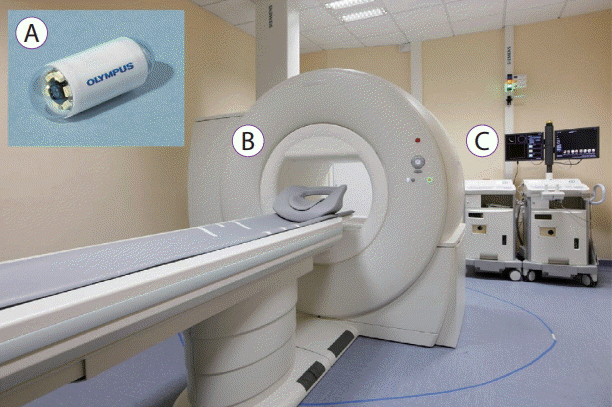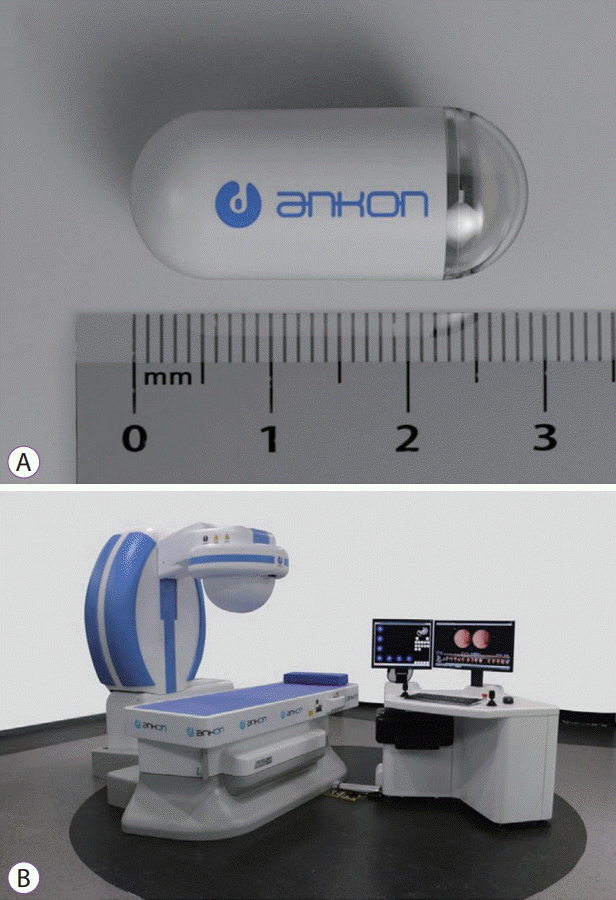1. ASGE Technology Committee, Wang A, Banerjee S, et al. Wireless capsule endoscopy. Gastrointest Endosc. 2013; 78:805–815.

2. Sidhu R, Sanders DS, McAlindon ME. Does capsule endoscopy recognise gastric antral vascular ectasia more frequently than conventional endoscopy? J Gastrointestin Liver Dis. 2006; 15:375–377.
3. Alkhormi AM, Memon MY, Alqarawi A. Gastric antral vascular ectasia: a case report and literature review. J Transl Int Med. 2018; 6:47–51.

4. Rey JF, Ogata H, Hosoe N, et al. Blinded nonrandomized comparative study of gastric examination with a magnetically guided capsule endoscope and standard videoendoscope. Gastrointest Endosc. 2012; 75:373–381.

5. Takahashi Y, Fujimori S, Toyoda M, et al. The blind spot of an EGD: capsule endoscopy pinpointed the source of obscure GI bleeding on the dark side of the pylorus. Gastrointest Endosc. 2011; 73:607–608.

6. Jun BY, Lim CH, Lee WH, et al. Detection of neoplastic gastric lesions using capsule endoscopy: pilot study. Gastroenterol Res Pract. 2013; 2013:730261.

7. Song HJ, Shim KN. Current status and future perspectives of capsule endoscopy. Intest Res. 2016; 14:21–29.

8. Peter S, Heuss LT, Beglinger C, Degen L. Capsule endoscopy of the upper gastrointestinal tract -- the need for a second endoscopy. Digestion. 2005; 72:242–247.

9. Delvaux M, Fassler I, Gay G. Clinical usefulness of the endoscopic video capsule as the initial intestinal investigation in patients with obscure digestive bleeding: validation of a diagnostic strategy based on the patient outcome after 12 months. Endoscopy. 2004; 36:1067–1073.

10. Kwack WG, Lim YJ. Current status and research into overcoming limitations of capsule endoscopy. Clin Endosc. 2016; 49:8–15.

11. Slawinski PR, Obstein KL, Valdastri P. Capsule endoscopy of the future: what’s on the horizon? World J Gastroenterol. 2015; 21:10528–10541.

12. De Falco I, Tortora G, Dario P, Menciassi A. An integrated system for wireless capsule endoscopy in a liquid-distended stomach. IEEE Trans Biomed Eng. 2014; 61:794–804.

13. Ciuti G, Caliò R, Camboni D, et al. Frontiers of robotic endoscopic capsules: a review. J Microbio Robot. 2016; 11:1–18.

14. Rahman I, Pioche M, Shim CS, et al. Magnetic-assisted capsule endoscopy in the upper GI tract by using a novel navigation system (with video). Gastrointest Endosc. 2016; 83:889–895. e1.
15. Lien GS, Liu CW, Jiang JA, Chuang CL, Teng MT. Magnetic control system targeted for capsule endoscopic operations in the stomach--design, fabrication, and in vitro and ex vivo evaluations. IEEE Trans Biomed Eng. 2012; 59:2068–2079.
16. Keller J, Fibbe C, Volke F, et al. Inspection of the human stomach using remote-controlled capsule endoscopy: a feasibility study in healthy volunteers (with videos). Gastrointest Endosc. 2011; 73:22–28.

17. Swain P, Toor A, Volke F, et al. Remote magnetic manipulation of a wireless capsule endoscope in the esophagus and stomach of humans (with videos). Gastrointest Endosc. 2010; 71:1290–1293.
18. Qian Y, Wu S, Wang Q, et al. Combination of five body positions can effectively improve the rate of gastric mucosa’s complete visualization by applying magnetic-guided capsule endoscopy. Gastroenterol Res Pract. 2016; 2016:6471945.

19. Mahoney AW, Abbott JJ. Five-degree-of-freedom manipulation of an untethered magnetic device in fluid using a single permanent magnet with application in stomach capsule endoscopy. Int J Rob Res. 2016; 35:129–147.
20. Yim S, Sitti M. Design and rolling locomotion of a magnetically actuated soft capsule endoscope. IEEE Trans Robot. 2012; 28:183–194.

21. Liao Z, Duan XD, Xin L, et al. Feasibility and safety of magnetic-controlled capsule endoscopy system in examination of human stomach: a pilot study in healthy volunteers. J Interv Gastroenterol. 2012; 2:155–160.

22. Keller H, Juloski A, Kawano H, et al. Method for navigation and control of a magnetically guided capsule endoscope in the human stomach. In : In: 2012 4th IEEE RAS & EMBS International Conference on Biomedical Robotics and Biomechatronics (BioRob); 2012 Jun 24-27; Rome, Italy. Piscataway Township (NJ). IEEE. 2012. p. 859–865.

23. Rey JF, Ogata H, Hosoe N, et al. Feasibility of stomach exploration with a guided capsule endoscope. Endoscopy. 2010; 42:541–545.

24. Denzer UW, Rösch T, Hoytat B, et al. Magnetically guided capsule versus conventional gastroscopy for upper abdominal complaints: a prospective blinded study. J Clin Gastroenterol. 2015; 49:101–107.
25. Ciuti G, Donlin R, Valdastri P, et al. Robotic versus manual control in magnetic steering of an endoscopic capsule. Endoscopy. 2010; 42:148–152.

26. Liao Z, Hou X, Lin-Hu EQ, et al. Accuracy of magnetically controlled capsule endoscopy, compared with conventional gastroscopy, in detection of gastric diseases. Clin Gastroenterol Hepatol. 2016; 14:1266–1273. e1.
27. Zou WB, Hou XH, Xin L, et al. Magnetic-controlled capsule endoscopy vs. gastroscopy for gastric diseases: a two-center self-controlled comparative trial. Endoscopy. 2015; 47:525–528.

28. Valdastri P, Webster RJ III, Quaglia C, Quirini M, Menciassi A, Dario P. A new mechanism for mesoscale legged locomotion in compliant tubular environments. IEEE Trans Robot. 2009; 25:1047–1057.

29. Quirini M, Menciassi A, Scapellato S, et al. Feasibility proof of a legged locomotion capsule for the GI tract. Gastrointest Endosc. 2008; 67:1153–1158.

30. Quirini M, Menciassi A, Scapellato S, Stefanini C, Dario P. Design and fabrication of a motor legged capsule for the active exploration of the gastrointestinal tract. IEEE ASME Trans Mechatron. 2008; 13:169–179.

31. Gorini S, Quirini M, Menciassi A, Pernorio G, Stefanini C, Dario P. SMA-based actuator for a legged endoscopic capsule. In : In: The First IEEE/RAS-EMBS International Conference on Biomedical Robotics and Biomechatronics; 2006 Feb 20-22; Pisa, Italy. Piscataway Township (NJ). IEEE. 2006. p. 443–449.
32. Park S, Park H, Park S, Kim B. A paddling based locomotive mechanism for capsule endoscopes. Journal of Mechanical Science and Technology. 2006; 20:1012–1018.

33. Kim HM, Yang S, Kim J, et al. Active locomotion of a paddling-based capsule endoscope in an in vitro and in vivo experiment (with videos). Gastrointest Endosc. 2010; 72:381–387.

34. Kim B, Lee S, Park JH, Park J-O. Design and fabrication of a locomotive mechanism for capsule-type endoscopes using shape memory alloys (SMAs). IEEE ASME Trans Mechatron. 2005; 10:77–86.

35. Kim B, Park S, Jee CY, Yoon S-J. An earthworm-like locomotive mechanism for capsule endoscopes. In : In: 2005 IEEE/RSJ International Conference on Intelligent Robots and Systems; 2005 Aug 2-6; Edmonton, Canada. Piscataway Township (NJ). IEEE. 2005. p. 2997–3002.

36. Morita E, Ohtsuka N, Shindo Y, et al. In vivo trial of a driving system for a self-propelling capsule endoscope using a magnetic field (with video). Gastrointest Endosc. 2010; 72:836–840.

37. Tortora G, Valdastri P, Susilo E, et al. Propeller-based wireless device for active capsular endoscopy in the gastric district. Minim Invasive Ther Allied Technol. 2009; 18:280–290.

38. Carta R, Tortora G, Thoné J, et al. Wireless powering for a self-propelled and steerable endoscopic capsule for stomach inspection. Biosens Bioelectron. 2009; 25:845–851.

39. Gorlewicz JL, Battaglia S, Smith BF, et al. Wireless insufflation of the gastrointestinal tract. IEEE Trans Biomed Eng. 2013; 60:1225–1233.

40. Pasricha T, Smith BF, Mitchell VR, et al. Controlled colonic insufflation by a remotely triggered capsule for improved mucosal visualization. Endoscopy. 2014; 46:614–618.

41. Ching HL, Hale MF, McAlindon ME. Current and future role of magnetically assisted gastric capsule endoscopy in the upper gastrointestinal tract. Therap Adv Gastroenterol. 2016; 9:313–321.

42. Imagawa H, Oka S, Tanaka S, et al. Improved detectability of small-bowel lesions via capsule endoscopy with computed virtual chromoendoscopy: a pilot study. Scand J Gastroenterol. 2011; 46:1133–1137.

43. Matsumura T, Arai M, Sato T, et al. Efficacy of computed image modification of capsule endoscopy in patients with obscure gastrointestinal bleeding. World J Gastrointest Endosc. 2012; 4:421–428.

44. Park S, Koo K-I, Bang SM, Park JY, Song SY, Cho D. A novel microactuator for microbiopsy in capsular endoscopes. J Micromech Microeng. 2008; 18:025032.

45. Kong K-C, Cha J, Jeon D, Cho D-I. A rotational micro biopsy device for the capsule endoscope. In : In: 2005 IEEE/RSJ International Conference on Intelligent Robots and Systems; 2005 Aug 2-6; Edmonton, Canada. Piscataway Township (NJ). IEEE. 2005. p. 1839–1843.

46. Valdastri P, Quaglia C, Susilo E, et al. Wireless therapeutic endoscopic capsule: in vivo experiment. Endoscopy. 2008; 40:979–982.

47. Swain P. The future of wireless capsule endoscopy. World J Gastroenterol. 2008; 14:4142–4145.

48. Rahman I, Kay M, Bryant T, et al. Optimizing the performance of magnetic-assisted capsule endoscopy of the upper GI tract using multiplanar CT modelling. Eur J Gastroenterol Hepatol. 2015; 27:460–466.








 PDF
PDF Citation
Citation Print
Print



 XML Download
XML Download